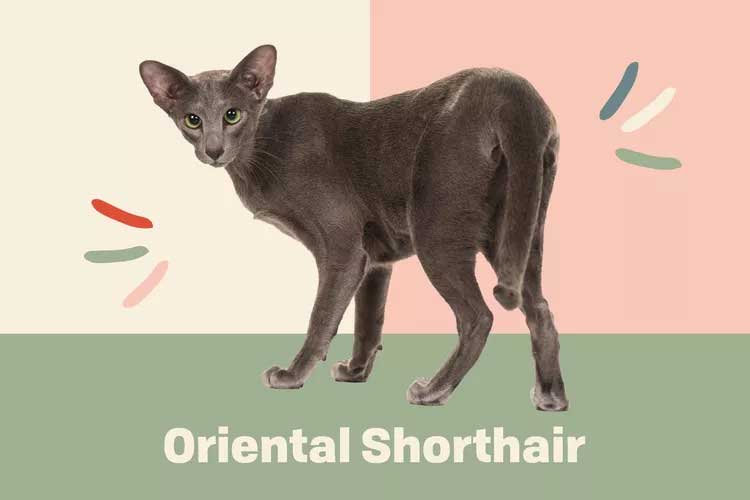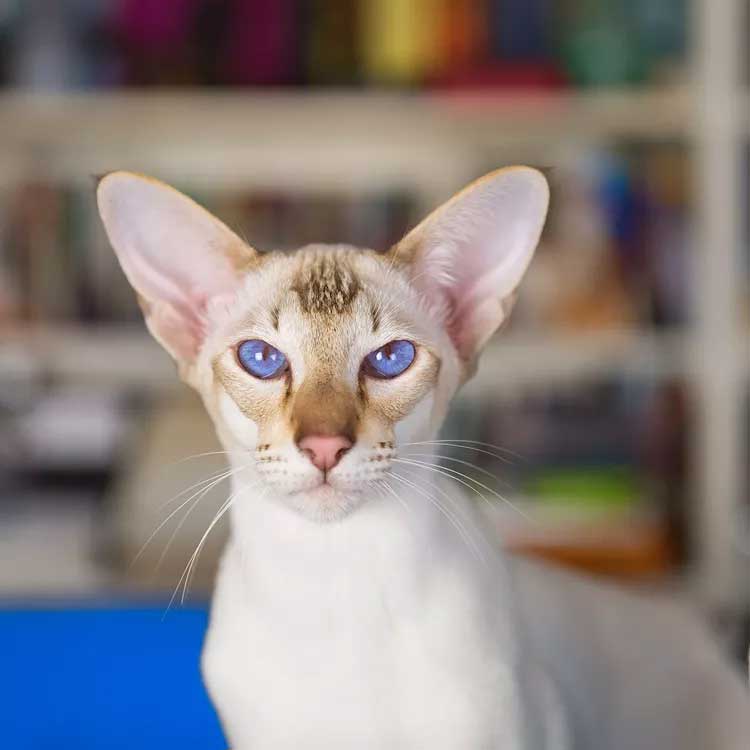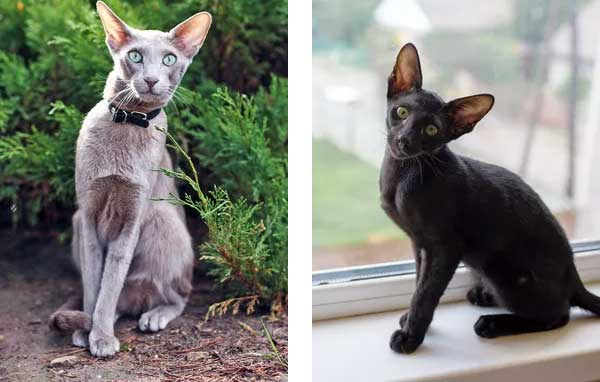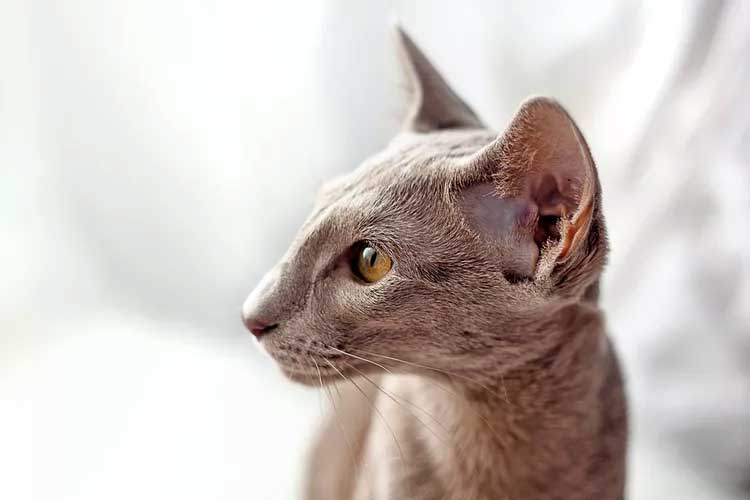Oriental shorthairs are friendly, intelligent, and inquisitive cats that love being around people and fellow furry friends. Learn more about living with this eye-catching breed.

Oriental Shorthair Overview
| OFFICIAL NAME | Oriental Shorthair |
| COMMON NAME | Oriental Shorthair |
| PET HEIGHT | 9 to 11 inches |
| PET WEIGHT | 8 to 12 pounds |
| LIFESPAN | 12 to 15 years |
| GOOD WITH | cats, children, dogs, families |
| TEMPERAMENT | affectionate, sociable |
| INTELLIGENCE | high |
| SHEDDING AMOUNT | normal |
| PLAYFULNESS | high |
| ENERGY LEVEL | active |
| VOCAL LEVEL | frequent |
| COAT LENGTH | short |
| COLORS | black / ebony, blue / gray, chocolate / brown / sable, cinnamon, cream / beige / tan, fawn, lavender / silver, lilac, red / orange, white |
| OTHER TRAITS | easy to groom, friendly toward humans, friendly toward other pets, friendly toward strangers, strong loyalty tendencies |
Oriental shorthairs don't just enter a room: They command it. From their large ears and angular faces to their long, slender frames, these stunning cats only look like they'd be standoffish. Their friendly, loving personality is quite the opposite.
Tina Gonzalez, proud pet parent to multiple Oriental shorthair cats who've become proper YouTube and Instagram celebrities, describes a typical day: "You will be subjected to carrying them around the house and, of course, leaving your lap available at all times for snuggling and napping. Your bed is their bed and many love to sleep under the covers, so closing the door at night is not advised."
The Oriental shorthair's sleek coat means grooming is a little easier than with his cousin cat, the Oriental longhair. And this big-eared breed tends to enjoy a longer lifespan—it's not unusual for an Oriental shorthair to live more than 15 years.
Though their looks are unusual and many might not be familiar with these felines, Oriental shorthairs aren't as rare as exotic cat breeds like the Khoa Manee or American Bobtail. But while you may find some Oriental shorthair kittens or cats available for adoption, a reputable breeder is the more common avenue to bringing one home.
Appearance
While the Oriental shorthair is technically a medium-sized cat at 8–12 pounds, their long, narrow frame gives them a much taller presence—and it also gives a hint about their history."Look closely and you'll see that [his] body structure is almost identical to the Siamese," says Teresa Keiger, editor at the Cat Fanciers' Association.

The big difference between the two breeds? The incredible variation in color and pattern. Oriental shorthairs come in virtually every hue from blue and lavender to ebony and with patterns including tortoiseshell and smoke. And like their name suggests, their coat is short, sleek, and shiny when brushed regularly. And while a completely hypoallergenic cat isn't exactly a reality, the Oriental shorthair can be a good choice for some allergy sufferers, alleviating sneezing and sniffles.
If that all wasn't appealing enough, the Oriental shorthair has one of the most unforgettable faces you'll see. Their wedge-shaped head creates an interesting distribution of facial features, with a long nose, almond eyes, and prominent cheekbones. And at the very top of that noggin? Large, upright ears reminiscent of a Chihuahua ... or Dobby the house elf from Harry Potter.
Temperament
Up for a chat? An Oriental shorthair is always in talkative mood, with an unusual cry that's commonly referred to as a honk. "They talk when they want something, want to know what's going on, what you're doing, or where you are," Keiger says.As you can probably guess, these cats are very social animals. Intelligent and affectionate, Oriental shorthair cats love to be around their families and other pets, particularly fellow felines. They're total "Velcro kitties," and often act as your second shadow.

"[They'll] get very attached to you, so that even if you walk to any part of your home, they will follow you unconditionally," Gonzalez says.
While their moderate energy levels don't make them the kind of lap cat that spends the day watching the world go by, they'll definitely seek out that lap when the mood hits. These kitties are equal parts snuggly and on-the-go.
Living Needs
Oriental shorthair cats can thrive in both homes and apartments. Their main living needs align with their social nature and activity levels—Oriental shorthairs always need a friend in sight and love to play and explore. This is mainly why Gonzalez recommends getting your cat a buddy: "Make sure to get more than one! They hate to be alone, and be very prepared to give up any free time to their whims and needs. They need constant stimulation and playtime."
While busy households may provide the excitement that'll appeal to the curious Oriental shorthair, it's not the best arrangement if you'll be frequently out of the house for long periods of time. These kitties get lonely! Conversely, if you're a homebody who needs a quiet atmosphere, the Oriental shorthair's honk and adorably chipper chatter may be a bit too "extra" for you.
As social butterflies, Oriental shorthairs are friendly and get along well with dogs and kiddos. But happy-go-lucky as they are, you should always supervise any pet with smaller children and teach your kids how to properly interact with animals.
Your Oriental shorthair will make good use of scratching and stretching on a cat tree, and might enjoy a high-up cat shelf, too. He loves to explore so much that you need to give him appropriate outlets to do so, otherwise you might find him on top of your refrigerator or opening kitchen cabinets to see what's inside.
Care
Oriental shorthair cats may be more popular than their longhair cousins due to their easy-to-care-for coats. Routine brushing will show off that sleek fur and help ease shedding, which happens year-round. An occasional cat bath or wipe-down also brings out the best in their coats.Their biggest grooming need isn't their short fur, but their big ears. You'll want to do a weekly check for wax and anything unusual. Your veterinarian can walk you through the task of preferred ear cleaning methods, but generally, a few drops of warm water on a cotton ball can be enough to gently swab those bat-like ears clean.

Then there's the typical cat care all breeds need: Trim their nails regularly (if you hear them clicking on the floor, they're too long) and make sure their litter box stays clean. And keep up with regular vet appointments to make sure your Oriental shorthair kitten stays healthy.
Regular play sessions with interactive cat toys will help stimulate an Oriental shorthair's need to explore while also keeping boredom at bay. (Remember, these cats are very smart and need to exercise their brains as well as their legs.) Having lots of one-on-one playtime is also an important social outlet for your cat—and, let's be real, for you too. Bonus: These play sessions are often followed by kitty cuddles.
Health
The Oriental shorthair lifespan is typically 12–15 years, but some can live well past that milestone. However, as with all breeds, there are some specific health issues to watch out for.Like the Abyssinian, Siamese, and Balinese breeds, Oriental shorthairs can be susceptible to Amyloidosis. According to the Oriental Cat Association, this is a serious condition where amyloid (an abnormal protein) forms deposits in tissues and organs. The deposits then lead to organ failure or death. Symptoms tend to develop before a cat is 5 years old, and it's believed to be an inherited condition. Unfortunately, there aren't currently any non-invasive or genetic tests to detect amyloidosis.

Another inherited condition that affects Oriental shorthairs is progressive retinal atrophy, a gradual form of vision loss that results in blindness. Cats who have this condition won't have any vision problems at birth but will begin showing signs of vision loss at seven months and lose their sight completely between the ages 3–5. Though genetic tests are available, there's no treatment.
But the average Oriental shorthair is typically the most preoccupied with obesity and dental issues. Regular exercise, keeping treats to a minimum, brushing your cat's teeth, and taking him to your vet for regular dental exams will help your cat live a happy and healthy life.
History
While it's easy to imagine these regal, statuesque cats hanging out with Cleopatra, the Oriental shorthair is actually a relatively new breed. They came about in the 1950s, when English breeders began crossing Siamese with other house cats (due to the decline of Siamese cats after World War II).It's believed that the first Oriental shorthair cats can be traced to black hybrids (a solid black cat with both Siamese and non-Siamese ancestry) and Russian blues, according to the CFA Oriental Breed Council. Siamese cats continued to be paired with different breeds, producing so many interesting colors and patterns that each considered their own unique breed. However, there soon became so many unique colors and patterns that the cats were grouped into one single breed: The Oriental shorthair.
Oriental shorthairs didn't cross the pond until the 1970s, but it didn't take long for them to make an impression. Just a few years after arriving in the U.S., the Oriental shorthair exploded in popularity. They were recognized by the Cat Fanciers' Association in 1977.
Fun Facts
Gonzalez's Oriental shorthair cat, Stache, became an instant celebrity when the internet discovered his resemblance to Star Wars actor Adam Driver. Stache—and his brothers Bindi, Teddy, and Dexter—are the stars of the viral hobbikats Youtube and Instagram accounts.All Oriental shorthairs, except those that have white in their fur, have green eyes.
Certain Oriental shorthair coats can also change color. Sun exposure can bring out rust-hued patches for black and blue cats, or pale yellow patches in brown and cinnamon varieties.
Oriental shorthair coats can come in over 300 different colors and color combinations.